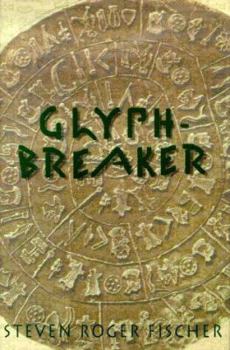Glyphbreaker
Select Format
Select Condition 
Book Overview
When he announced his successful decipherment of the Rongorongo script of Easter Island in 1996, Steven Roger Fischer joined the ranks of the great decipherers of all time. No one had ever deciphered... This description may be from another edition of this product.
Format:Hardcover
Language:English
ISBN:0387982418
ISBN13:9780387982410
Release Date:September 1997
Publisher:Springer
Length:234 Pages
Weight:1.30 lbs.
Dimensions:0.9" x 6.4" x 9.5"
Customer Reviews
4 ratings
A Wonderful Detective Novel whith the Author as Criminal...
Published by Thriftbooks.com User , 22 years ago
... or hero. This book is on the border between very serious research and pure invention. It is exciting to read Fischer's claims, well knowing that he may be completely wrong. Just like when you read a detective novel, the reader can repeatedly ask himself: "does that argument hold?", "what if it's like this instead?" or "why didn't anyone think about that before?" No one can deny that Fischer spent a lot of energy and thought on the effort to decypher the Faistos disk, and following his thoughts is as intriguing as reading Agatha Christie. Between Fischer's sometimes questionable conclusion there are plenty of interesting facts about history, culture and language of the Antiqity. His style is easy to follow and captivating, regardless of if his result is the final truth (which he thinks himself) or just imagination (which I tend to hold).If this book had been published as fiction, I would have given it five stars.
Glyph Breaker is a wonderful example of science as it ought
Published by Thriftbooks.com User , 27 years ago
Writing about breaking the Japanese NL military code before World War II, Rear Admiral Edwin T. Layton said "...only two hundred intercepts (messages) were ever made, a totally inadequate number for the penetration of any cipher system."I recalled this as I read "Glyph Breaker" by Steven Roger Fischer. Fischer, using but a single example (intercept) of a Minoan clay disk containing a mere 241 pictorial symbols, managed to decipher the script as an ancient call to arms. Glyph Breaker is Fischer's story of how he deciphered this and also the enigmatic Rapanui script of Easter Island, Rongorongo. To decipher the Phiastos Disk, Fischer had to overcome a terrible problem. He knew in advance neither what the various characters on the disk represented, nor what was the underlying language. In contrast, military code breakers generally know the underlying language, even if encryption makes it unreadable. A comparable example is using Navajo as a code during WWII, a language the Japanese neither understood, identified or ever deciphered. Thus, encryption of an unknown language makes a devilish problem.How Fischer set about deciphering the disk makes not only an interesting story in itself, but is a superb example of science in practice. He began with an internal analysis of the symbols and their order; that is, with the information content of the message. In this endeavor Fischer was lucky to have a long and complete text sequence. The 241 characters of the Phiastos Disk may not seem long, but it is longer than any comparable text in the collection of 57,000 Linear B (Mycenean) glyphs. Virtually the lot of these consisted of accounting for stores of goods, and took Michael Ventris five years to decipher. The sample texts of the as yet undeciphered Minoan Linear A script are even shorter. The entire 7,000 glyph collection of which consists of short accounting marks, dedications, and manufacturer's marks. Deciphering Linear A is like trying to reconstruct English from credit card r! eceipts and coffee cups.Once the internal analysis yielded what it could, Fischer then placed the message in a context. This means simply a guess at the point of origin of the Phiastos Disk, but this was not easy to do. For decades scholars had argued that the disk was not a Minoan work, despite being found in a Minoan Palace. Some even speculated that the Minoans themselves were not Indo-European. Fischer guessed that the disk was indeed Minoan. Whatever language they may have spoken, Minoans would certainly reflect influences of their neighbors by making reference to local places and tribes. Recognizing tribal and place names gave Fischer not only the essential clues for breaking the code, but also provided tests of the decipherment. This general decipher method works because the evolution and succession of languages leaves proper names recognizable. To a linguist familiar with the underlying language of a text, proper names stand out as glaring anomalies. Layton, for example,
A good book, but, sadly, a bit too "popular"
Published by Thriftbooks.com User , 27 years ago
There is no question that the author is a genius; what else might one reasonably call a person who has broken two previously undeciphered scripts, in unknown languages? This book is a very popularized account of what was done. Hopefully, it will stir a few people to become interested in the subject. While I'm happy to have the insights into the author's personal travails and triumphs, I could wish that there had been a bit more technical information in the book.
a chronicle of two extraordinary intellectual conquests
Published by Thriftbooks.com User , 27 years ago
Ever wondered how Champollion felt deciphering Egyptian hieroglyphs? Or Rawlinson decoding cuneiform? Steven Roger Fisher actually explains how he cracked two, completely different, unknown scripts. Even more amazing is the clarity of the explanation. Courses in linguistics should be so compelling. This may be the most impressive intellectual achievement ever.






